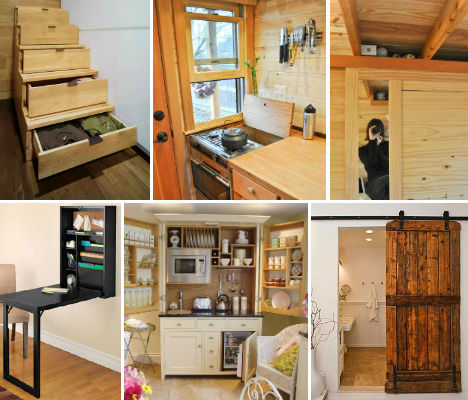Sustainable Space-Saving: Eco-Friendly Designs Making a Difference in Small Homes
In our modern age, where urban living spaces are increasingly compact, finding ways to make small homes both livable and sustainable is essential. The trend toward smaller homes is not merely about space constraints, but a conscious choice to reduce our ecological footprint. Large homes not only require more energy to heat and cool, but they consume vast quantities of building materials, which can have detrimental environmental effects. By rethinking the way spaces are used, small homes can be both charming and sustainable.
Eco-friendly and space-saving designs are gaining popularity as people strive to live more sustainably. By optimizing available space and incorporating green design principles, these compact homes offer innovative solutions that make a significant environmental impact. Whether through using fewer resources during construction, or employing energy-efficient features, small homes demonstrate that bigger isn't always better.
Smart Use of Space for Eco-Friendly Living
One of the critical aspects of sustainable small homes is maximizing every inch of space. Creative storage solutions allow residents to live comfortably without being overwhelmed by possessions. The "27 Space-Saving Tricks and Techniques for Tiny Houses" provide a wealth of ideas, such as utilizing hidden compartments, lofted beds, and fold-away furniture that help in managing space efficiently. As highlighted, smart storage designs, like pull-out cabinets in bathrooms and space-efficient stairs with built-in storage, enable effective space management in minute areas.
Furthermore, in areas typically overlooked, spaces near ceilings or beneath floors can be converted into storage or functional spaces. This creativity not only allows for comfort within a small home but also reduces the need for extra square footage, and consequently, the resources needed for construction and maintenance.
By considering each square foot as valuable space, tiny house dwellers have inspired broader thinking in urban design, proving that living with less doesn't mean sacrificing comfort or style.

Green Building Techniques That Optimize Resources
Sustainable design encompasses much more than aesthetics; it involves building techniques that effectively utilize resources, minimize waste, and augment the natural environment. Many small eco-friendly homes, such as those discussed in "18 Incredible Small Green Homes That Live Large", exemplify this approach.
By utilizing recycled materials, passive solar heating, and efficient insulation, these homes showcase how modern green architecture continues to evolve. Modular and prefabricated homes also play a vital role in sustainable building due to their ability to reduce construction waste drastically. Taking inspiration from traditional and new innovative design approaches, these homes reflect an increasing societal shift towards sustainability.
The idea of repurposed materials, such as shipping containers, for building homes is another innovative method. This approach not only recycles shipping containers but also offers structural integrity and cost-efficiency, making high-quality home building accessible to a wider audience.
Energy Efficiency in Small Homes
Energy efficiency is at the heart of sustainable home design. Compact homes, by their very nature, require less energy to heat, cool, and power. In addition to reducing reliance on fossil fuels, these homes often use solar panels as their primary energy source, harnessing the sun's power to maintain a comfortable environment.
Advanced designs integrate energy-efficient lighting solutions such as LED lights and appliances that carry Energy Star certifications. In some instances, developers have included systems that allow small homes to operate entirely off-grid, promoting energy independence and sustainability.
For instance, homes like the "Watershed House" in Oregon utilize natural lighting, effective insulation, and resource-efficient systems to create an environmentally friendly and self-sustaining residence. By integrating these features, homeowners extend their environmental consciousness while enjoying the economic benefits associated with reduced utility costs.
The Role of Prefabrication and Modular Design
Prefabricated and modular designs are rapidly gaining traction as a means to ensure sustainability in small homes. These techniques minimize on-site waste and labor costs, and the controlled production environment helps achieve high-quality results.
These homes, which can include features such as passive solar gain, green roofs, and water recycling systems, highlight the intersection between sustainability and contemporary architectural design. As shown in many "Green Home Building" projects, modular homes can adapt to various environmental conditions and personal preferences, promoting a flexible living that traditional construction cannot easily provide.
Modular homes also find favor among those living in environmentally sensitive areas, as they minimize disturbance to the natural landscape during construction. Thus, by choosing prefabricated or modular homes, one can significantly decrease their environmental impact while enjoying aesthetic and structural benefits.
Conclusion: Small Steps Toward a Bigger Impact
Small homes, though limited in size, make a considerable impact when designed with sustainability in mind. The willingness to embrace a minimalistic lifestyle and employ creative design solutions contributes to the conservation of resources and reduction of environmental impact. From ingeniously compact designs that use space efficiently to homes built using recycled materials, every effort counts toward a greener future.
As urban areas continue to densify, sustainable small homes present an opportunity to address housing needs economically and environmentally. The fusion of modern design, energy efficiency, and sustainable materials results in homes that not only meet the needs of their occupants but also respect the planet.
The ongoing challenge is to broaden the adoption of these innovative practices, encouraging more stakeholders in the housing industry to implement eco-friendly solutions on a larger scale. As more people adopt these sustainable practices, the cumulative effect will lead to a significant reduction in humanity's carbon footprint.